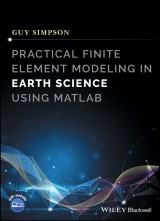Details
Practical Finite Element Modeling in Earth Science using Matlab
1. Aufl.
|
89,99 € |
|
| Verlag: | Wiley-Blackwell |
| Format: | EPUB |
| Veröffentl.: | 13.03.2017 |
| ISBN/EAN: | 9781119248668 |
| Sprache: | englisch |
| Anzahl Seiten: | 320 |
DRM-geschütztes eBook, Sie benötigen z.B. Adobe Digital Editions und eine Adobe ID zum Lesen.
Beschreibungen
<p>Mathematical models have become a crucial way for the Earth scientist to understand and predict how our planet functions and evolves through time and space. The finite element method (FEM) is a remarkably flexible and powerful tool with enormous potential in the Earth Sciences. This pragmatic guide explores how a variety of different Earth science problems can be translated and solved with FEM, assuming only basic programming experience.</p> <p>This book begins with a general introduction to numerical modeling and includes multiple sample Matlab codes to illustrate how FEM is implemented in practice. Textboxes have been included to provide additional detail, such as specialized Matlab usage or advanced topics. Covering all the key aspects, this is essential reading for those looking to master the technique, as well as those simply seeking to increase their basic level of understanding and appreciation of FEM.</p>
<p>Preface xiii</p> <p>Symbols xv</p> <p>About the Companion Website xvii</p> <p><b>Part I The Finite Element Method with Matlab 1</b></p> <p><b>1 Preliminaries 3</b></p> <p>1.1 Mathematical Models 3</p> <p>1.2 Boundary and Initial Conditions 4</p> <p>1.3 Analytical Solutions 5</p> <p>1.4 Numerical Solutions 5</p> <p>1.5 Numerical Solution Methods 7</p> <p>1.6 Matlab Script 8</p> <p>1.7 Exercises 10</p> <p>Suggested Reading 12</p> <p><b>2 Beginning with the Finite Element Method 13</b></p> <p>2.1 The Governing PDE 13</p> <p>2.2 Approximating the Continuous Variable 14</p> <p>2.3 Minimizing the Residual 15</p> <p>2.4 Evaluating the Element Matrices 17</p> <p>2.5 Time Discretization 18</p> <p>2.6 Assembly 19</p> <p>2.7 Boundary and Initial Conditions 21</p> <p>2.8 Solution of the Algebraic Equations 21</p> <p>2.9 Exercises 22</p> <p>Suggested Reading 23</p> <p><b>3 Programming the Finite Element Method in Matlab 25</b></p> <p>3.1 Program Structure and Philosophy 25</p> <p>3.2 Summary of the Problem 25</p> <p>3.3 Discretized Equations 26</p> <p>3.4 The Program 27</p> <p>3.4.1 Preprocessor Stage 27</p> <p>3.4.2 Solution Stage 29</p> <p>3.4.3 Postprocessor Stage 30</p> <p>3.5 Matlab Script 30</p> <p>3.6 Exercises 33</p> <p>Suggested Reading 34</p> <p><b>4 Numerical Integration and Local Coordinates 35</b></p> <p>4.1 Gauss–Legendre Quadrature 36</p> <p>4.2 Local Coordinates 37</p> <p>4.3 Evaluating the Integrals 39</p> <p>4.4 Variable Material Properties 40</p> <p>4.5 Programming Considerations 41</p> <p>4.6 Matlab Script 43</p> <p>4.7 Exercises 45</p> <p>Suggested Reading 47</p> <p><b>5 The Finite Element Method in Two Dimensions 49</b></p> <p>5.1 Discretization 50</p> <p>5.2 Geometry and Nodal Connectivity 52</p> <p>5.3 Integration of Element Matrices 54</p> <p>5.4 Multielement Assembly 57</p> <p>5.5 Boundary Conditions and Solution 60</p> <p>5.6 Matlab Script 61</p> <p>5.7 Exercises 65</p> <p>Suggested Reading 66</p> <p><b>6 The Finite Element Method in Three Dimensions 67</b></p> <p>6.1 Discretization 67</p> <p>6.2 Element Integration 69</p> <p>6.3 Assembly for Multielement Mesh 72</p> <p>6.4 Boundary Conditions and Solution 73</p> <p>6.5 Matlab Program 74</p> <p>6.6 Exercises 79</p> <p>Suggested Reading 80</p> <p><b>7 Generalization of Finite Element Concepts 81</b></p> <p>7.1 The FEM for an Elliptic Problem 84</p> <p>7.2 The FEM for a Hyperbolic Problem 96</p> <p>7.3 The FEM for Systems of Equations 102</p> <p>7.4 Exercises 116</p> <p>Suggested Reading 116</p> <p><b>Part II Applications of the Finite Element Method in Earth Science 119</b></p> <p><b>8 Heat Transfer 121</b></p> <p>8.1 Conductive Cooling in an Eroding Crust 122</p> <p>8.2 Conductive Cooling of an Intrusion 126</p> <p>Suggested Reading 135</p> <p><b>9 Landscape Evolution 137</b></p> <p>9.1 Evolution of a 1D River Profile 138</p> <p>9.2 Evolution of a Fluvially Dissected Landscape 143</p> <p>Suggested Reading 150</p> <p><b>10 Fluid Flow in Porous Media 151</b></p> <p>10.1 Fluid Flow Around a Fault 152</p> <p>10.2 Viscous Fingering 157</p> <p>Suggested Reading 166</p> <p><b>11 Lithospheric Flexure 167</b></p> <p>11.1 Governing Equations 167</p> <p>11.2 FEM Discretization 168</p> <p>11.3 Matlab Implementation 171</p> <p>Suggested Reading 181</p> <p><b>12 Deformation of Earth’s Crust 183</b></p> <p>12.1 Governing Equations 183</p> <p>12.2 Rate Formulation 185</p> <p>12.3 FEM Discretization 186</p> <p>12.4 Viscoelastoplasticity 188</p> <p>12.5 Matlab Implementation 190</p> <p>Suggested Reading 205</p> <p><b>13 Going Further 207</b></p> <p>13.1 Optimization 207</p> <p>13.2 Using Other FEMs 213</p> <p>13.3 Use of Existing Finite Element Software 215</p> <p>Appendix A Derivation of the Diffusion Equation 217</p> <p>Appendix B Basics of Linear Algebra with Matlab 221</p> <p>Appendix C Comparison between Different Numerical Methods 227</p> <p>Appendix D Integration by Parts 237</p> <p>Appendix E Time Discretization 239</p> <p>References 241</p> <p>Index 245</p>
<p><b>Guy Simpson</b> obtained his PhD in Geology from ETH Zurich. He is currently within the Department of Earth Science at the University of Geneva. Over the past decade, he has taught numerous courses at the Universities of Geneva, École Normale Supérieure in Paris, and ETH Zurich on numerical modeling in Earth science using Matlab. He also uses this method in his own research that includes investigation of earthquakes, tectonics and erosion of active mountain ranges, fluid flow, magmatism, and tsunamis.</p>
<p>Mathematical models have become a crucial way for the Earth scientist to understand and predict how our planet functions and evolves through time and space. The finite element method (FEM) is a remarkably flexible and powerful tool with enormous potential in the Earth sciences. This pragmatic guide explores how various Earth science problems can be translated and solved with FEM, assuming only basic programming experience.</p> <p>This book begins with a general introduction to numerical modeling and includes multiple sample Matlab codes to illustrate how FEM is implemented in practice. Covering all the key aspects, this is essential reading for those looking to master the technique, as well as those simply seeking to increase their basic level of understanding and appreciation of FEM.


















